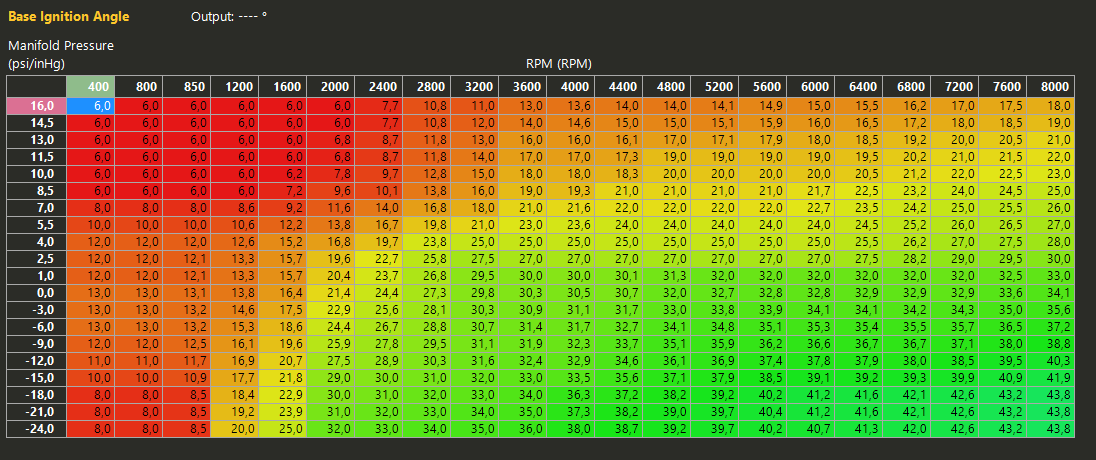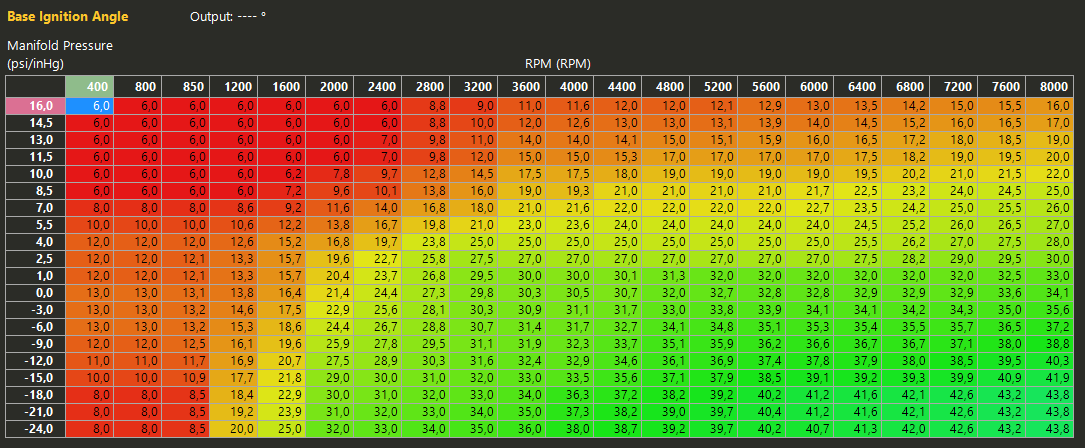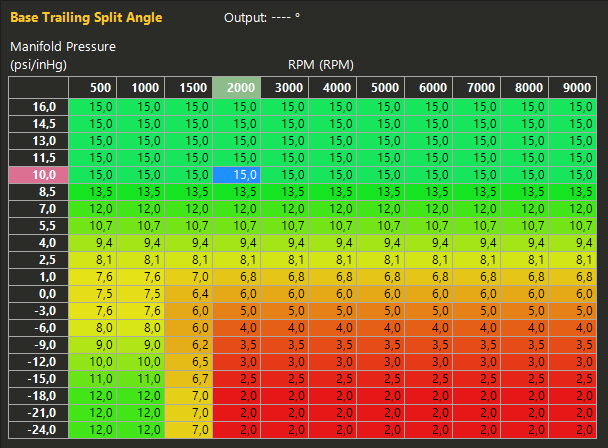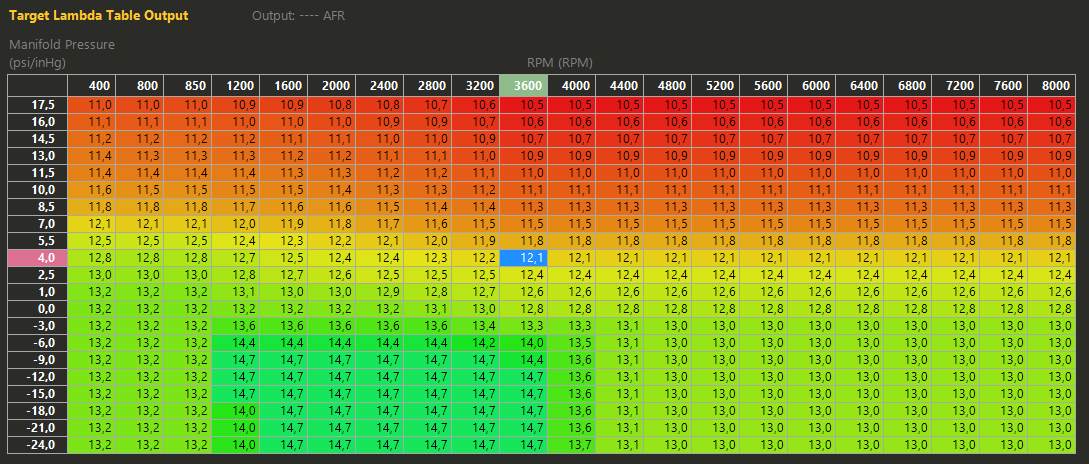Timing Map
#1
Timing Map
Hello,
I have a 88 T2 with the 8.5:1 Rotors and stock turbo for now. Do these Timing Maps/AFR maps look good?
They are mostly based on Arghx Rtek maps. Also im using 100 Octane(EU) which is about 95-96(US)
https://drive.google.com/file/d/1Exn...ew?usp=sharing
I have a 88 T2 with the 8.5:1 Rotors and stock turbo for now. Do these Timing Maps/AFR maps look good?
They are mostly based on Arghx Rtek maps. Also im using 100 Octane(EU) which is about 95-96(US)
https://drive.google.com/file/d/1Exn...ew?usp=sharing
#4
Hopefully it's ok for your fuel. I wouldn't run that on 98RON / 93 AKI. Now I say that based on general experience. You don't have any dyno results or anything like that. If you can access a dyno, I'd start pulling spark a bit at high boost and see how much power you lose. If it's only 1-2 horsepower per degree, you can take a little timing out for more safety.
Note that my bias is always towards safety.
If you can't do any kind of dyno verification soon, I'd pull 1 degree out of 10psi row, and 2 degrees out of 11.5 and higher rows. Then I'd set split to 15 degrees from 8.5psi row and higher, and set target AFR .2 richer at 7psi, .3 richer at 8.5 psi, and .5 richer for all boost rows above it. Just change the entire rows.
You always have to keep in mind that I don't know how well tuned you are for hot starts, track type driving, cold evenings, high water and air temperature, heatsoaked intercooler etc etc. That's where things go wrong, the old "it was fine the other day, I don't know what happened" problem. So you initially have to bake in big safety margins for "off nominal" conditions, or you'll be another guy who put the pedal down in 3rd gear one day and went boom. Then as you collect more dyno data, track data, drag racing data, etc you can evaluate how much safety margin you're willing to give up for additional power.
It's a different way of thinking than the "I just took my car to the tuner and he got me x power, take a look at my dyno sheet" mentality.
Note that my bias is always towards safety.
If you can't do any kind of dyno verification soon, I'd pull 1 degree out of 10psi row, and 2 degrees out of 11.5 and higher rows. Then I'd set split to 15 degrees from 8.5psi row and higher, and set target AFR .2 richer at 7psi, .3 richer at 8.5 psi, and .5 richer for all boost rows above it. Just change the entire rows.
You always have to keep in mind that I don't know how well tuned you are for hot starts, track type driving, cold evenings, high water and air temperature, heatsoaked intercooler etc etc. That's where things go wrong, the old "it was fine the other day, I don't know what happened" problem. So you initially have to bake in big safety margins for "off nominal" conditions, or you'll be another guy who put the pedal down in 3rd gear one day and went boom. Then as you collect more dyno data, track data, drag racing data, etc you can evaluate how much safety margin you're willing to give up for additional power.
It's a different way of thinking than the "I just took my car to the tuner and he got me x power, take a look at my dyno sheet" mentality.
Last edited by arghx; 03-02-23 at 08:59 AM.
The following 2 users liked this post by arghx:
j9fd3s (03-02-23),
MetalSkinGaming (03-08-23)
#6
also i based the boost timing mostly on the timing maps you posted here.
https://www.rx7club.com/rtek-forum-1...g-maps-885556/
specifically on the moderate one. are the rtek timing values different from the haltech ones? or did i read something wrong?
https://www.rx7club.com/rtek-forum-1...g-maps-885556/
specifically on the moderate one. are the rtek timing values different from the haltech ones? or did i read something wrong?
#7
One of the main points of that timing map thread was to explain different concepts of what makes a map more conservative vs more aggressive. It's to teach a concept. There's an important context lost here. The people in that thread were coming from the old chipped Rtek ECUs, which calculated timing based on the airflow meter. See this thread on the stock S4 TII timing maps. Stock s4 turbo timing maps: a warning to those on the stock ECU - RX7Club.com - Mazda RX7 Forum
When actually tuning the car, you're limited by your time on the street and in a dyno. In that case you want to start with the extra conservative modifications I suggested above, and then gradually advance timing/lean out the tune, to something like the original maps you posted. Each change needs a different dyno sheet with an ECU log, and some kind of spreadsheet tracking the progression. You should talk to the dyno operator and have them export the dyno run datafiles or an image of the dyno sheet for EVERY run, or if you're attempting some kind of virtual dyno software thing track each pull.
Again this is actually doing it in a very thorough way... as a process of making a custom tune. If you just want to copy something in there and not blow up, I'd copy the "conservative" map in there with the "conservative" AFR table (different thread: Rtek New target AFR tables - RX7Club.com - Mazda RX7 Forum , adjust to your scaling as you see fit) and only run with your 100RON fuel and appreciate the extra safety of 8.5:1 rotors and higher octane pump fuel.
Maybe 13 years ago when I made that timing thread I didn't make it fully clear, but I wouldn't actually just put that moderate map in there as a starting point and drive around with it for a year without any dyno tuning or a bunch of other careful tuning done. That's unnecessary risk. Maybe I'm even more cautious now than I was 13 years ago.
So I'll leave you with this: "Engine longevity is remembered long after horsepower-left-on the table is forgotten" ... an allusion to the famous Gucci quote, "Quality is remembered long after price is forgotten."
When actually tuning the car, you're limited by your time on the street and in a dyno. In that case you want to start with the extra conservative modifications I suggested above, and then gradually advance timing/lean out the tune, to something like the original maps you posted. Each change needs a different dyno sheet with an ECU log, and some kind of spreadsheet tracking the progression. You should talk to the dyno operator and have them export the dyno run datafiles or an image of the dyno sheet for EVERY run, or if you're attempting some kind of virtual dyno software thing track each pull.
- Run #1 - X peak power @ rpm Y peak torque @ rpm with "timing map 2.map" and "AFR table 1.map" -- dyno sheet 1.jpg - intake air temp 25C
- Run #2 - X peak power @ rpm Y peak torque @ rpm with "timing map 2.map" and AFR table 1.map" -- dyno sheet 2.jpg - intake air temp 29C
- etc etc with differnt combinations of AFR and timing, recording all sorts of stuff
Again this is actually doing it in a very thorough way... as a process of making a custom tune. If you just want to copy something in there and not blow up, I'd copy the "conservative" map in there with the "conservative" AFR table (different thread: Rtek New target AFR tables - RX7Club.com - Mazda RX7 Forum , adjust to your scaling as you see fit) and only run with your 100RON fuel and appreciate the extra safety of 8.5:1 rotors and higher octane pump fuel.
Maybe 13 years ago when I made that timing thread I didn't make it fully clear, but I wouldn't actually just put that moderate map in there as a starting point and drive around with it for a year without any dyno tuning or a bunch of other careful tuning done. That's unnecessary risk. Maybe I'm even more cautious now than I was 13 years ago.
So I'll leave you with this: "Engine longevity is remembered long after horsepower-left-on the table is forgotten" ... an allusion to the famous Gucci quote, "Quality is remembered long after price is forgotten."
Last edited by arghx; 03-02-23 at 02:12 PM.
The following users liked this post:
MetalSkinGaming (03-08-23)
Trending Topics
#8
Moderator
iTrader: (3)
Joined: Mar 2001
Posts: 31,201
Likes: 2,825
From: https://www2.mazda.com/en/100th/
i looked at a couple of logs from my car (FC with an REW and stock FC turbo), and i'm running less timing in the ~7-10psi boost area. in fact i'm running the PFC base map with the couple negative split spots fixed, and then it has retarded a couple of cells for knock.
the other thing is that ive got a knock reading and pre turbo EGT, and its been nice to have. you can pull timing see egt go up, so there is some sweet spot where knock is low and EGT is also low.
the third thing, is that i was always told to start tuning all the way rich, and then lean it out until it runs and then richen it up a tad. obviously in 2023 we can be more targeted, but IMHO you still want to start too rich, at least at WOT
actually in 2023 the target map is nice, but your job as a tuner is to make sure the car actually hits it.
the other thing is that ive got a knock reading and pre turbo EGT, and its been nice to have. you can pull timing see egt go up, so there is some sweet spot where knock is low and EGT is also low.
the third thing, is that i was always told to start tuning all the way rich, and then lean it out until it runs and then richen it up a tad. obviously in 2023 we can be more targeted, but IMHO you still want to start too rich, at least at WOT
actually in 2023 the target map is nice, but your job as a tuner is to make sure the car actually hits it.
The following users liked this post:
MetalSkinGaming (03-08-23)
#9
i have a pre turbo egt installed and i also have a knock sensor installed but i dont really use the knock sensor as i dont want to make the engine knock to find out the frequency of knock. i have it set at 3.5k atm but it wont retard when it sees knock because from what ive read if it knocks its already too late anyways.
i was running really conservative timing before but i still had the stock intercooler on and got intake temps of like 70C or so and egt reached over 900C at 5k rpm with 9psi boost. im currently fabbing up a v-mount to improve temps.
i was running really conservative timing before but i still had the stock intercooler on and got intake temps of like 70C or so and egt reached over 900C at 5k rpm with 9psi boost. im currently fabbing up a v-mount to improve temps.
Last edited by MetalSkinGaming; 03-03-23 at 03:07 PM.
#10
900C EGT is at the top end of normal. You'll even see piston engines running those kind of temps, between 900 and 1000C. I wouldn't go any higher than 900C if you value the life of your turbo.
The following users liked this post:
MetalSkinGaming (03-08-23)
#13
Looks good.
The Target AFR seems rich... but until you know how consistently you're controlling AFR according to the target, you're aiming on the richer side. If you're targeting 10.8:1 ... but on cold evenings you're running more boost, and your fuel control isn't precise, you're now pushing more air through and the AFR is drifting to 11.8:1 ... you're not as rich as you think. Your limiting factor are the exceptional situations where you can cause engine damage. If you're highly confident at your ability to control to the target then of course you can go leaner. This is a starting point.
The Target AFR seems rich... but until you know how consistently you're controlling AFR according to the target, you're aiming on the richer side. If you're targeting 10.8:1 ... but on cold evenings you're running more boost, and your fuel control isn't precise, you're now pushing more air through and the AFR is drifting to 11.8:1 ... you're not as rich as you think. Your limiting factor are the exceptional situations where you can cause engine damage. If you're highly confident at your ability to control to the target then of course you can go leaner. This is a starting point.
Last edited by arghx; 03-07-23 at 01:10 PM.
The following users liked this post:
MetalSkinGaming (03-08-23)
The following users liked this post:
MetalSkinGaming (03-08-23)
#16
Yes closed loop control will bring you much closer to the target. You may have to tune the gains (controller sensitivity) though. It can overshoot/undershoot, or oscillate. Also, if your open loop compensation tables are good (air temp, water temp, after start stuff etc) that will also get you close to the target. It's the same thing with idle tuning, any kind of control system. You can set a target idle speed and have idle air feedback, but if your throttle body isn't set up right and your idle timing is jacked up your closed loop idle air control isn't going to solve the problem.
The whole point though is that the closed loop controls won't work very well at first. So we make it extra safe, confirm the hardware is configured correctly (no air leaks etc etc) get the open loop/feed forward control pretty close, then tune the closed loop control.
The whole point though is that the closed loop controls won't work very well at first. So we make it extra safe, confirm the hardware is configured correctly (no air leaks etc etc) get the open loop/feed forward control pretty close, then tune the closed loop control.
Last edited by arghx; 03-08-23 at 11:54 AM.
The following users liked this post:
scotty305 (03-08-23)
Thread
Thread Starter
Forum
Replies
Last Post
HHTurboVert
Engine Management Forum
4
01-25-09 04:34 AM









